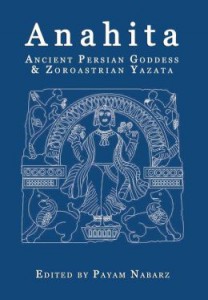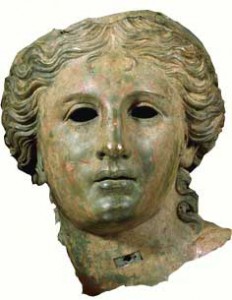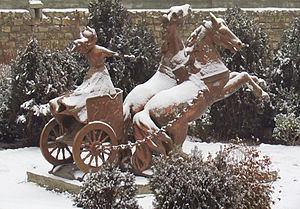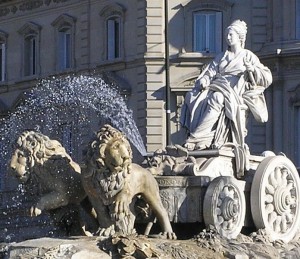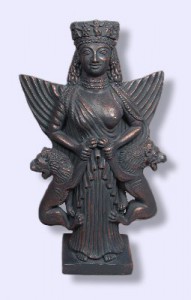Anahita, Ancient Persian Goddess & Zoroastrian Yazata
edited by Payam Nabarz
Avalonia Books, ISBN 978-1905297306
From Avalonia books: “The Indo-Iranian Anahita is an ancient Persian Goddess, who became a Zoroastrian Yazata (or Angel) and is still part of contemporary Zoroastrianism. Described as a beautiful maiden, who is strong, tall and pure, she is depicted as wearing a mantle embroidered with gold and as holding the baresma (sacred plant) in her hand. She is the Goddess of all the waters upon the earth, her full title being Aredvi Sura Anahita which means moist, mighty and immaculate (pure), and she travels on her chariot pulled by four horses: Wind, Rain, Cloud and Sleet. Closely associated with the King’s investiture she is a Goddess of Sovereignty, thought by some to be the Persian Aphrodite, who also has some remarkable similarities to numerous other ancient goddesses, including Ishtar, Venus, Nana and Isis.
Bronze Head of Anahita, reign of Tigranes; Hellenic 1st Century BCE, Armenia
Anahita: Ancient Persian Goddess and Zoroastrian Yazata is a collection of papers, art and poetry celebrating this fascinating Goddess from more than 25 esteemed international academics, Zoroastrians, artists and writers. Each in turn share their research and insights leading the reader on a journey of discovery – from the Achaemenid Royal Inscriptions featuring Anahita and Mithra, to the possible relationships between Anahita and the Dame du Lac of Arthurian Legend, representations of her in Sassanian art, William Morris Hunt through to Anahita as the pre-Christian Virgin Mother of Mithra, as well as her role in purification and purity. Studies of the Sassanian rock reliefs, hot mineral springs, and her water ritual in Mahāyāna Buddhism, in addition to an examination of the Sassanid stucco discovered in the Barz-e-qawela in Lorestan province of Iran and women in ancient Elam are all brought together illustrating the significance of Anahita throughout Persian and Middle Eastern history.
This book is the most extensive study of the figure of Anahita in recent years, and includes new and never published before research. Anahita: Ancient Persian Goddess and Zoroastrian Yazata is essential reading for all those interested not just in this Goddess and her history, but also all those interested in Persian and Middle Eastern history.”
I was particularly interested in this book because of my own interest in ANATOLIA. I had wondered before if the name Anahita and Anatolia were linked. And although there wasn’t a direct link there was enough material in this book, that my curiosity was more than quenched when I started reading this wonderful collection of essays.
The meaning and origin of Anatolia, the ancient name of Asia Minor, from M.L. Anatolia, from Gk. anatole ’the east’, originally ‘sunrise’ (which of course happens in the east), lit. ‘a rising above (the horizon)’, from anatellein ’to rise’, from ana ‘up’ +tellein ’to accomplish, perform’. Anahita means in sanskrit ‘who nurtures crops and herds’. Also ‘immaculate’, that is pure. She is the Ancient Persian Goddess of water, fertility, war and the patroness of women.
As the immaculate, the pure and untouched, it is not difficult to follow the reasoning for historians to have connected Anahita to the cult of the Great Goddess, whether it is Cybele, Ishtar or Aphrodite. In this collection of essays we read about “Anahita’s Water Ritual in Mahayana Buddhism” to references in Arthurian Legends.
Statue of Anahita in Maragha, Iran
.. and the Fountain of Cibeles, Madrid, Spain
So what started out as a wish to to find out more about Anatolia and deities in the area (Asia Minor) … I discovered that Anahita was far more than a local Goddess.
From the Zoroastrian text Aban Yasht 5: “Angel-Goddess of all the waters upon the earth and the source of the cosmic ocean; you who drive a chariot pulled by four horses: wind, rain, cloud and sleet; your symbol is the eight-rayed star. You are the source of life, purifying the seed of all males and the wombs of all females, also cleansing the milk in the breasts of all mothers. Your connections with life means warriors in battle prayed to you for survival and victory.
A maid, fair of body, most strong, tall-formed, high girded, pure… wearing a mantle fully embroidered with gold; ever holding the baresma [sacred plant] in your hand.. you wear square golden earrings on your ears… a golden necklace around your beautiful neck… Upon your head… a golden crown, with a hundred stars, with eight rays… with fillets streaming down.”
Thanks to Payam Narbarz and Sorita d’Este & David Rankine from Avalonia Books for this important contribution.
Contributors include: Dr. Israel Campos Méndez, Dr. Kaveh Farrokh, Dr. Matteo Compareti, Sheda Vasseghi, D.M. Murdock, Dr. Sam Kerr, Rahele Koulabadi, Dr. Seyyed Rasool Mousavi Haji, Morteza Ataie, Seyed Mehdi Mousavi Kouhpar, Seyyed Sadrudin Mosavi Jashni, Farhang Khademi Nadooshan, Hassan Nia, Masoud Sabzali, Dr. Masato Tojo, Behzad Mahmoudi, Amir Mansouri, Dr Kamyar Abdi, Dr Gholamreza Karamian, Maryam Zour, Saman Farzin, Babak Aryanpour, Reza MehrAfarin, Akashanath, Shapour Suren-Pahlav, Ana C. Jones, Katherine Sutherland, and Dr. Payam Nabarz.
Anahita, the Lioness Lady and Queen of Beasts
[British Museum, 500 BCE]
References:
http://en.wikipedia.org/wiki/Anahita
http://en.wikipedia.org/wiki/Anatolia
http://ancientweb.org/index.php/explore/country/Armenia
http://www.goddessgift.net/anahita-lady-of-beasts-SS-LB.html

